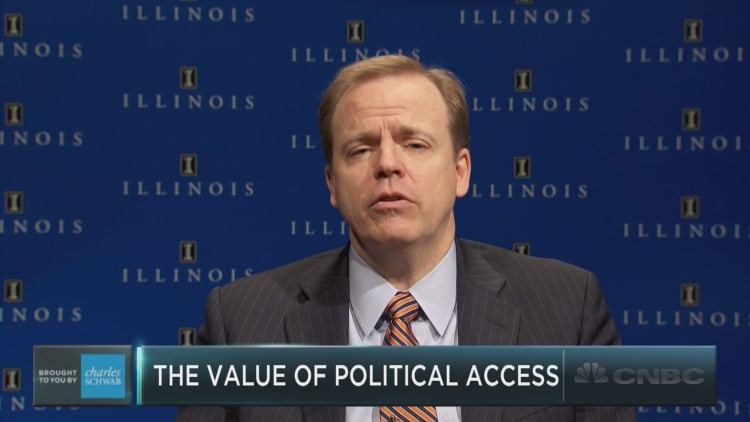
When executives pay the White House a visit, their shareholders should cheer.
At least, that's what a paper entitled "All the President's Friends: Political Access and Firm Value" by two University of Illinois at Urbana-Champaign finance professors would suggest.
Jeffrey Brown and Jiekun Huang found that the share prices of companies whose executives visited the White House saw an average boost of 1 percent in the two months after the visits. The finding was based on White House visitor logs maintained and made public during the Obama administration.
"There's clearly real value to having the ability to access senior officials within a White House," Brown, who is also the dean of the University of Illinois College of Business, said in a Friday interview on CNBC's "Trading Nation."
"We went into it with the hypothesis that this was interesting to look at because what we know is lots of companies spend a lot of effort, time, energy and money trying to access political leaders," he said.
Through more than 2,200 corporate executive visits between January 2009 and December 2015, Brown and Huang discounted visits associated with large gatherings, or those associated with any kind of advisory board to the president, that were likely not company-specific.
So which companies have been the most connected? In that time period, the top three most frequent visitors were then chairman and CEO of Honeywell International, David Cote (he is now executive chairman), with 30 visits; General Electric's executive chairman and CEO, Jeffrey Immelt, with 22 visits; and EverCore Partners' senior chairman, Roger Altman, with 21 visits.
Notably, the president himself was not even the most visited member in the White House. Valerie Jarrett, former senior advisor to the president, was visited the most — 107 times — by corporate executives, followed by Jeff Zients, former director of the National Economic Council, with 103 visits. President Barack Obama was visited a mere 100 times.
Brown surmised that three factors have driven these excess returns around White House visits. Regulatory news in the two months after a visit tended to be more positive for companies whose executives visited the White House, relative to otherwise similar entities who did not. Also, companies were more likely to see an increase in government contracts after a visit.
Additionally, in the months after visits, a firm's investment sensitivity to political risk was seen as having been "dampened or reduced, suggesting that there might have been a useful exchange of information about the policy environment," Brown said. The report also takes into consideration that executives' meetings with the president and top officials are covered by the media, perhaps influencing stocks' performance shortly after the events.
In Brown's opinion, the findings say more about the interaction between government and business than about the Obama administration in particular.
"I have every reason to believe this type of finding would hold regardless of the party in power," Brown wrote to CNBC. "The reason we could only study the Obama Administration is that they are the only Admin that released the full visitor logs."
The Trump administration, returning to a tradition broken by Obama, has decided not to release visitor logs, though his meetings with executives have received ample attention from the news media.





